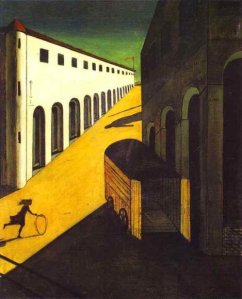
Sometimes the horizon is defined by a wall behind which rises the noise of a disappearing train. The whole nostalgia of the infinite is revealed to us behind the geometrical precision of the square. We experience the most unforgettable movements when certain aspects of the world, whose existence we completely ignore, suddenly confront us with the revelation of mysteries lying all the time within our reach and which we cannot see because we are too short-sighted, and cannot feel because our senses are inadequately developed. Their dead voices speak to us from nearby, but they sound like voices from another planet.
–Giorgio de Chirico
***************
I am busy this morning but wanted to share a post from several years ago about painter Giorgio de Chirico. I thought I’d run it again today with the addition at the bottom of one of his more famous paintings and a short MoMA video about it. The idea that is presented about the metaphysics contained in dealing not with “perceived reality” but a “reality imagined” and of creating “a plausible representation of a believable and negotiable space” rang a bell for me as that is the space where I try to operate. Take a look.
 A turning point for me when I was first stumbling around with my own painting was when I encountered the work of Giorgio de Chirico, an Italian painter of darkly toned metaphorical works. He lived from 1888 until 1978 but was primarily known for his early work from 1909-1919 which is called his Metaphysical Period. Metaphysics is devoted to the exploration of what is behind visible reality without relying on measurable data.
A turning point for me when I was first stumbling around with my own painting was when I encountered the work of Giorgio de Chirico, an Italian painter of darkly toned metaphorical works. He lived from 1888 until 1978 but was primarily known for his early work from 1909-1919 which is called his Metaphysical Period. Metaphysics is devoted to the exploration of what is behind visible reality without relying on measurable data.
His work from this defining ten year period is very mystical.
De Chirico’s work after 1919 became much more based in reality and far more traditional. This later work was less colorful, less symbolic, less powerful and way more mundane. It is definitely the work from the earlier Metaphysical period that defines him as the artist as we know him today.
I was immediately drawn to that early work. It was full of high contrast, with sharp light and dark. The colors were bold, bright and vibrant, yet there was darkness implied in them. The compositions were full of interesting juxtapositions of forms and perspectives, all evoking a sense of mystery. It was a visual feast for me.
implied in them. The compositions were full of interesting juxtapositions of forms and perspectives, all evoking a sense of mystery. It was a visual feast for me.
At that time in my own painting, I was still painting in a fairly traditional manner, especially with watercolors. That is to say that I was achieving light through the transparency of my paint, letting the underlying paper show through. It was pretty clean which was fine. But it wasn’t what I was looking for in my work.
Seeing de Chirico’s paintings made me realize what I wanted. It was that underlying darkness that his work possessed. It was a grittiness, a dark dose of the reality of our existence. I immediately began to experiment with different methods that would introduce a base of darkness that the light and color could play off. Plus, his ability to create a reality that seemed possible and recognizable but seemed filled with mystery was something aspired for in my own pieces.
Working with this in mind, my work began to change in short order and strides forward came much quicker as a result of simply sensing something in de Chirico’s work that wasn’t there in my own.
Perhaps that is what is meant by metaphysical…











